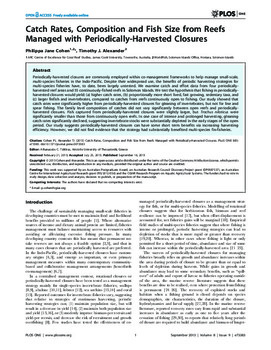Catch rates, composition and fish size from reefs managed with periodically-harvested closures

Citation
Cohen, P.J.; Alexander, T.J. (2013). Catch rates, composition and fish size from reefs managed with periodically-harvested closures. PLoS ONE, 8(9):e73383
Periodically-harvested closures are commonly employed within co-management frameworks to help manage small-scale, multi-species fisheries in the Indo-Pacific. Despite their widespread use, the benefits of periodic harvesting strategies for multi-species fisheries have, to date, been largely untested. We examine catch and effort data from four periodically-harvested reef areas and 55 continuously-fished reefs in Solomon Islands. We test the hypothesis that fishing in periodically-harvested closures would yield: (a) higher catch rates, (b) proportionally more short lived, fast growing, sedentary taxa, and (c) larger finfish and invertebrates, compared to catches from reefs continuously open to fishing. Our study showed that catch rates were significantly higher from periodically-harvested closures for gleaning of invertebrates, but not for line and spear fishing. The family level composition of catches did not vary significantly between open reefs and periodically-harvested closures. Fish captured from periodically-harvested closures were slightly larger, but Trochus niloticus were significantly smaller than those from continuously open reefs. In one case of intense and prolonged harvesting, gleaning catch rates significantly declined, suggesting invertebrate stocks were substantially depleted in the early stages of the open period. Our study suggests periodically-harvested closures can have some short term benefits via increasing harvesting efficiency. However, we did not find evidence that the strategy had substantially benefited multi-species fin-fisheries.
Permalink
Date Available
Type
Publisher
Countries
Research Themes
Language